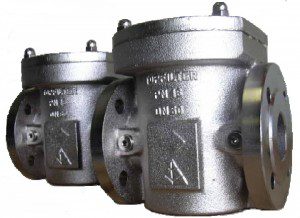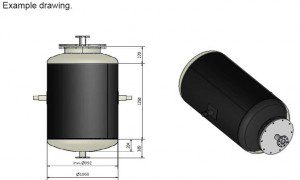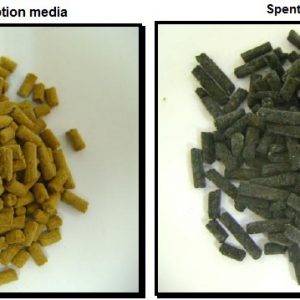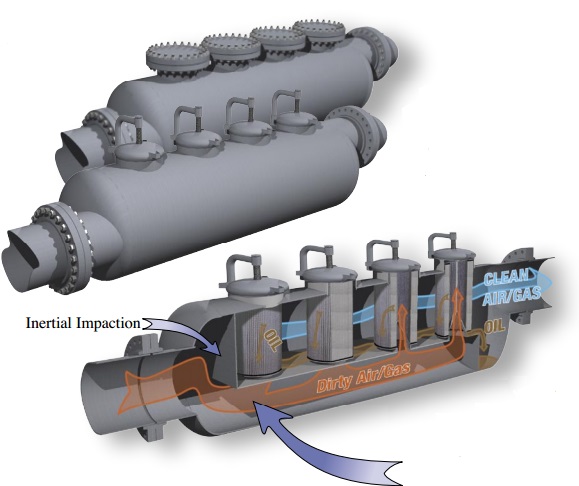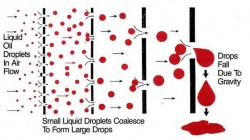Oil absorption filter candles
Oil absorption filter cartridges
On this page you can find all other products that are not tied to a separate category.
Think of multi-stage pipelines or coalescence.
These products are perhaps less important but certainly not indispensable!
Do not restrain yourself and take a look between our other products and maybe there is just the product that you are looking for!
-
(Bio)gas Filter Coalescer
CleanFlow’s filter coalescer is specifically designed for Biogas treatment. Separation of dry contaminants from biogas and natural gas. Also available with additional coalescing function to separate oil mist and aerosols. Especially suitable for corrosive nature of Biogas with H2S content.
Read moreFilter housing type CF-BG
The CleanFlow Biogas Filter is a ductile cast iron gas filter with flat cover and flanged connections. The filter holds a unique rectangular shaped filter cartridge. Unmatched large filter surface area per filter cartridge size compared to conventional cylindrical cartridges. The cartridge has its own integrated o-ring seal.
Advantages:
- Interchangeable with conventional cylindrical filters due to identical installation length
- Multi purpose. The coalescing function can easily be exchanged into dry filtration by using another type of filter
- cartridge and blocking of the liquid drain
- Separates oil mist, condensates and solid particles
- Extremely efficient downstream a compressor or gas engine
- Easy maintenance
- Low cost
- Light weight ductile cast-iron – aluminium
- No silicone materials applied: silicone will degrade in natural gas
- Full incinerable cartridges in cellulose/polyester-quality and optional higher micro-quality
- Filtration area twice the area of comparable cylindrical filter cartridges
- Equal installation length like conventional cylindrical filters: interchangeable
- Larger sump than conventional cylindrical filters
- Optional: High Temperature execution (HTB) PN 1 bar / 14,5 psi (650 °C/1202 °F. 30 min)
Technical data:
- EC type examination cert.: Product-ID-Nr. CE-0085AT0293 / DVGW-Nr. NG-4505AT0180
- Medium: Natural gas acc. DIN-DVGW specification G260, and other non aggressive technical gases
- Operating pressure: Max. 16 bar or 25 bar
- Temperature range: Operating temp.: -10°C up to 70°C (short term 120°C @pH7) optional: -20°C available
- Flange connection: 1” – 4” DIN PN16 or PN 25 optional ANSI 150# (PN 6 version now available)
- Differential pressure: Max. allowable differential pressure: ΔP = 1 bar
- ΔP-connection: Standard ΔP-connections G ¼” at both sides
- optional: G 1” drain at extra cost
Materials of construction:
- Filter housing: Ductile cast iron alumunium GGG 40
- Cover: Carbon steel RSt 37-2
- Gaskets: Precision O-ring, natural gas resistant acc. DIN 3535
- Optional: Inspection certificate acc. DIN 50049/3.1.B (at extra cost)
-
Activated Carbon (media) Filter Vessel
The activated carbon (media) filter vessel is available in different construction materials and dimensions. It will be custom designed and made to fit your specific filtration needs. The media vessel can be manufactured complete with a support frame.
Read more
Tilt mechanisme.
The media vessel is equipped with hinges and a tilt mechanism in the frame so it can be tilted during filter media exchange. As a result the exchange of the media is very easy and safety is guaranteed.The top lid can be opened after tilting the filter vessel. The media will flow easily from the vessel to a waste container or big bag. Personnel no longer need to enter the vessel and the danger of suffocation or poisoning by remaining gases is eliminated.
-
H2S and Sulphur adsorption media
BIO Fe Adsorption media is granular clay based media impregnated with a ferric hydroxide medium. The adsorption media removes H2S and Sulphur compounds from air and gas streams. Other components of energetic value such as Methane will pass through the media and can be easily used as fuel.
This product is particularly efficient in the Biogas energy recovery process.
It has a high H2S removal capacity in anaerobic conditions.
Working temperature range 25 to 90ºC
Read more
H2S is stripped from the gas stream according to the following chemical reactions. The ferric hydroxide coating on BIO Fe reacts with H2S:- 2Fe(OH)3 + H2S » 2Fe(OH)2 + 2H2O + 1/8 S8
- 2Fe(OH)2 + 2H2S » 2FeS + 4H2O
This reaction results in the creation of ferrous sulphide, which turns the media black.
Regeneration Operation: BIO Fe can be easily regenerated. The Ferrous Sulphide can be converted back to Ferric Hydroxide by blowing air through the media filter.
2FeS + 3/202 + 3H2O » 2Fe(OH)3 + 1/4S8
Oxygen converts the FeS (Ferrous Sulphide) to ferric hydroxide and elemental sulphur that remains trapped in the media.
There is a visual colour indicator to show when the media is returning from Black (saturated media) to its original light Brown colour with small sulphur particles attached.
10 to 19 Regeneration Operations are possible, a minimum adsorption capacity of 400 mg H2S per gram of BIO Fe media. Each regeneration operation will absorb 40mg of H2S per gram of media. If Oxygen is present in small quantities in the Biogas, there is constant regeneration of the media through the Oxygen in the air flow.
Biogas Power Production Operational Cost
The Operational Costs to produce Electricity can be much higher if there is no Corrosion Control in Biogas recovery process. Biogas contains H2S that must be removed as much as possible before reaching the gas processing equipment. H2S causes severe problems with the gas processing equipment as the equipment is extremely sensitive to hydrogen sulphide. If H2S is removed, we can improve equipment efficiency by reducing maintenance, reventing downtime, and enhancing energy production. The hydrogen sulphide issue is a critical factor for technologies that use the biogas. If the H2S levels are too high, damage to gas treatment equipment is severe and costly.
Active Sulphur Compounds rapidly attack copper, silver, aluminium and iron alloys. The presence of moisture and small amounts of inorganic chlorine compounds greatly accelerates sulphide corrosion. Active Sulphurs ranks with inorganic chlorides as the predominant cause of atmospheric corrosion in the process industries. STANDARD ISA-S71.04-1985
-
Multiple stage coalescing pipeline filter separator
CleanFlow introduces a new coalescing multiple stage pipeline filter for the removal of solids and fluids from natural gas. Our unique CPF series filter separator combines 3 separation techniques in one compact filter housing. Integrated fluid slug catcher, gravitational settlement and coalescence filtration.
Read more
A unique advantage of the innovative filter design is the integrated slug catcher. Instead of the usual 2 separate units for slug catcher and filter separator only one piece of equipment is required. This new CPM series filter is a horizontal pipeline filter with extended surface area vertical elements. Element service life has been extended tenfold and more. Complete service can be accomplished with a single 3/4” adjustable wrench in a very short time.Our CPF series of filters remove solid particles and fluids out of natural gas and other types of gas, vastly reducing or eliminating service to engines, turbines compressors, valves, meters and other components. Superior filtration is achieved first through inertial impaction, secondly through gravitational settling, and thirdly through a nearly vertical coalescing multi-stage filter element with efficiencies down to 0.03 micron or higher micron rating if required.
Filter separator properties:
- Connection size : 6″ – 24″
- Flow rates (max) : 13.600 – 900.000 Nm³/hr
- Design pressure : 12 -200 bar
Advantages:
- Horizontal design with vertical filter elements. Compact construction
- Proven to provide the best coalescencing and filtration result
- Integrated slug catcher
- Quick opening and closing
- Fast and easy maintenance with short down time
Filter element properties:
- Designed as standard for 1 bar (15 psi) differential pressure
- Particulate removal efficiency of 99.25% of 0.1 micron, 99.99% > 0.7 micron
- Oil aerosol removal efficiency of 90% of 0.1 µm, 98% of 0.3 µm, 99% of 0.7 µm
Filter element design:
- Polyurethane moulded ends
- Multiple layer composite pleat pack media with proprietary packing
- No tools required for installation or removal
- Double O-ring seal design
- Filter media has been independently lab tested using various oils as contaminants
What is coalescing?
Coalescing is separation of fluid aerosols and droplets from a gas. Wet gas flows from the inside to the outside through a coalescing filter cartridge which is installed in a filter housing. The inner filter layer is made of a highly efficient coalescing media and the outer layer is a coarser drainage layer.
The fine fibres of the inner layer catches the fine fluid aerosols and droplets. Next they go through the depth of the filter cartridge to form bigger droplets on the fibres of the filter media. When the droplets reach the outside surface of the cartridge they fall in the sump compartment from which it is drained. Coalescing filter cartridges will remover particles with the same efficiency as solids filter cartridges with the same grade.

